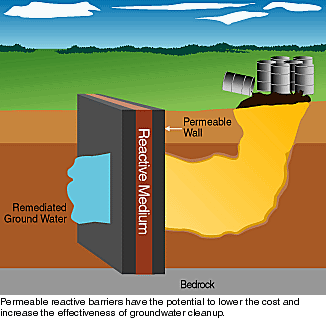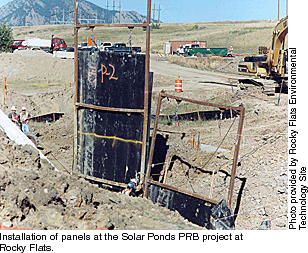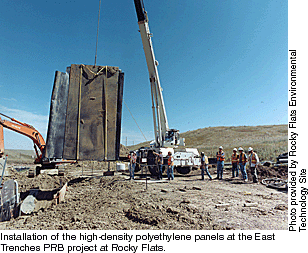
Groundwater remediation became an environmental priority in the United States after the passing of CERCLA (1980) and RCRA (1984), which mandated and regulated cleanup of hazardous substances. At the time, the most commonly used approach was to pump contaminated water to the surface and treat it using carbon filtration or an air-stripping procedure—both pump-and-treat methods. In the last decade, pump-and-treat systems have been operating at numerous DOE sites and have become the baseline technology for cleanup of contaminated groundwater. However, there are several drawbacks to this traditional approach. A pump-and-treat system requires an external energy source, which is very costly when operated for long periods of time. Also, because much of the water pumped initially is uncontaminated, pump and treat is often wasteful of groundwater resources. In 1994, permeable reactive treatment walls, also known as passive reactive barriers
(PRBs), EPA reports that 35 PRB systems have been deployed across the country, using zero-valent iron or other reactive material such as granulated carbon. Some experts estimate that more than 500 sites in the United States may be suitable for PRB deployment over the next 10 years. Compared to pump and treat, PRBs could save more than $1 billion per site over a long-term operation. Currently, PRBs are built in two basic configurations—the funnel-and-gate and the continuous (or trench) PRB. Both configurations require some degree of excavation and are limited to fairly shallow depths of 50 to 70 feet or less. The funnel-and-gate design uses impermeable walls (sheet pilings, slurry walls, etc.) to "funnel" or direct the contaminant plume to "gates" containing the reactive material. The continuous PRB design completely transects the plume flow path with reactive materials. Oak Ridge hosts demonstration of PRBs At DOE’s Oak Ridge Y-12 Plant in Tennessee, the Office of Science and Technology’s Subsurface Contaminants Focus Area helped sponsor the construction of two pilot-scale PRB systems to identify, test, and evaluate the barriers’ ability to remove inorganic and organic contaminants from groundwater migrating to Bear Creek. Leached wastes from disposal ponds have contaminated both groundwater and surface water with nitric acid, uranium, and technetium. In November 1997, Oak Ridge National Laboratory installed a continuous-trench PRB system in an area designated Pathway 2. It is 225 feet long, 2 feet wide, and 25 to 30 feet deep and filled with gravel, except for a 26-foot section in the middle that is filled with 80 tons of zero-valent iron. In December 1997, MSE Technology Application installed a funnel-and-gate system in an area designated Pathway 1. It is 220 feet long and about 25 feet deep and consists of two wing walls designed to funnel groundwater to a concrete vault containing treatment canisters for evaluating different treatment media. The treatment vault consists of five vertically stacked reactors, which ease the cleaning and replacing of used or clogged iron. One of the retrievable canisters contains iron fitted with electrodes for electrochemical treatment. The total installation cost for the two walls was approximately $1 million, including the cost of design, construction, materials, and the reactive material. The zero-valent iron in these systems removes uranium and technetium through redox-driven precipitation and sorption to iron oxyhydroxide byproducts. Chlorinated organics are destroyed through dehalogenation. Monitoring at Pathway 2 has revealed the following:
Continued monitoring of these pilot-scale barriers at Y-12 is expected to yield dividends in advancing the PRB technology. As coprincipal investigator Baohua Gu says, "While PRB is a promising and cost-effective technology for removing a number of organic and inorganic contaminants, issues of long-term performance due to surface passivation and mineral precipitation, system clogging, microbial impact, and hydraulic capture remain to be evaluated." ASTD projects aim to clean plumes Several PRB projects have received funding through OST’s Accelerated Site Technology Deployment Program. In
FY98, ASTD funds were awarded to projects at DOE’s Grand
Junction Office and its Kansas City Plant. In FY99, a Rocky
Flats Environmental Technology Site (RFETS) project titled "Passive Reactive
Barrier Collection and Treatment of Groundwater" won ASTD funding to repeat the
success the Colorado site has been experiencing through a FY98 demonstration project
jointly sponsored by Rocky Mountain Remediation Services,
OST’s Subsurface Contaminants Focus Area, and EPA’s Superfund Innovative Technology Evaluation Program.
The 1998 PRB demonstration project has been treating volatile organic compounds (VOCs) and
radionuclides in a groundwater plume generated by leaking drums formerly buried at the
Mound Site disposal trench. The demonstration barrier is approximately 250 feet long and
15 to 20 feet deep. "During the first year of operation, monitoring has shown the
contaminants of concern in the effluent stream to be below detection limits," reports
Lane Butler, principal investigator with Kaiser-Hill Co. "Based on the success of the
demonstration project, we are currently installing two other large-scale PRBs." Solar Ponds Plume These projects, both with partial funding from ASTD, are also cooperative ventures—among DOE’s Rocky Flats Field Office, RFETS, and OST. Although the Solar Evaporation Ponds were taken out of service in 1986 and their sediments and sludge removed in 1995, leaching contaminated the groundwater with uranium and nitrate. The Solar Ponds Plume PRB, whose installation was completed in September 1999, uses high-density polyethylene panels to funnel groundwater toward a concrete treatment cell that has two compartments: organic sawdust mixed with iron filings to remove nitrates and reactive iron as a final polishing step. Performance data is not yet available from the Solar Ponds plume system. East Trenches Plume The East Trenches plume system, also completed in September 1999, also consists of
high-density polyethylene panels for funneling groundwater. The East Trenches treatment
cell contains reactive Norma Castaneda, project manager of the East Trenches and Solar Ponds PRB projects, talked about some of the problems her team encountered during installation of the subsurface barriers. "With the depth of the collection trench up to 30 feet, a major issue is slope stability during installation. Steep, unstable slopes tend to slump. It’s also important to protect the piping between the treatment cells during backfill operations. The backfill must be compacted to prevent settling." Advancing the technology through collaborations Knowing that collaboration between agencies and among scientists is imperative for the successful launch of a new technology or process, the Remediation Technologies Development Forum established the PRB Action Team, one of seven action teams, in March 1995. EPA created RTDF in 1992 to foster collaboration between the public- and private-sectors in finding innovative solutions to mutual hazardous waste problems. The PRB Action Team’s mission is to accelerate the development of cost-effective permeable barrier technologies for mitigating chlorinated solvents, metals, radionuclides, and other pollutants in groundwater. As part of its mission, the PRB Action Team collaborated with EPA to publish a summary of the state-of-the-art of PRB technology, Permeable Reactive Barrier Technologies for Contaminant Remediation (EPA/600/R-98/125, December 1998). The Action Team has also collaborated with EPA and the Interstate Technology and Regulatory Cooperation (ITRC) Work Group to offer a training course that will assist regulatory professionals in overseeing design, implementation, and monitoring of groundwater remedies involving deployment of PRBs. The first course, offered in June 1999 in Boston, was attended by almost 180 participants. Courses are planned for each EPA Region through September 2000. ITRC is actively involved in defining the regulatory implications associated with the installations of PRBs. Despite the progress the PRB Action Team has made, it believes that the primary factor restricting further acceptance and deployment of the PRB technology is data on the technology’s long-term performance. So the PRB Action Team is coordinating a research approach by EPA (National Risk Management Research Laboratory), DOE (Office of Science and Technology, EM-50), and DOD (Environmental Security Technology Certification Program) to address long-term PRB performance. The three agencies will conduct their evaluations at sites under their individual purview but will use common techniques and measuring approaches so that information collected can be pooled and some general conclusions can be made. DOE’s portion of the project will focus on its PRB projects at the Y-12 Plant at Oak Ridge, Tennessee; the Rocky Flats demonstration project at the Mound Site in Colorado; and the Kansas City Plant in Missouri. Despite the considerable strengths of the PRB technology, there have been some hitches. In a recent RTDF PRB Action Team conference call, participants noted that inadequate site characterization is often cited as the root of the problem when PRBs perform suboptimally. Variability in site geology, groundwater chemistry, and site-specific cleanup requirements require careful site characterization and PRB design. The PRB technology is not one-size-fits-all. However, proponents of the PRB technology believe that once site characterization issues are addressed and long-term performance data is collected, PRBs will become the groundwater remediation system of choice. More information Relevant to this subject is a report published by EPA’s Technology Innovation Office, Groundwater Cleanup: Overview of Operating Experience at 28 Sites (EPA 542-R-99-006). It compiles information from 28 case studies of groundwater cleanup systems, including 26 pump-and-treat systems, two permeable reactive barriers, and one site where a reactive barrier replaced a pump-and-treat system. The 28 case studies, as well as 112 other studies, are available at http://www.frtr.gov under "Cost and Performance," or download the report from http://clu-in.org/techpubs.htm, under "CLU-IN publications in the October 1999 TechDirect message." For hard copies, call (800) 490-9198 or (513) 489-8190. For updates on PRB technologies at DOE sites, see the Subsurface Contaminants Focus Area Web site at http://www.envnet.org/scfa. For more information on the Oak Ridge Y-12 PRB demonstration project, contact Baohua Gu at (865) 574-7286, b26@ornl.gov or David Watson at (865) 241-4729, v6i@ornl.gov. Lane Butler, principal investigator on the Mound PRB demonstration, can be reached at (303) 966-5245. To find out more about the recently installed Solar Ponds and East Trenches PRBs at RFETS, contact Norma Castaneda at (303) 966-4226, norma.castaneda@rfets.gov. For information on the RTDF PRB Action Team, check the RTDF Web site at http://www.rtdf.org. For a schedule of the course "In Situ Permeable Reactive Barriers: Application and Deployment," see the ITRC Web site at http://www.itrcweb.org. |

 became a viable
alternative to pump and treat. PRBs are a group of emerging technologies used to
treat/degrade chemicals in groundwater in situ. The concept of PRBs is relatively simple.
A permeable, subsurface barrier containing a reactive material (such as granular iron) is
constructed across the path of a contaminant plume. When groundwater passes through the
reactive barrier, contaminants are either immobilized or chemically transformed to a more
desirable state (e.g., less toxic or more readily biodegradable). For example, when a
chlorinated hydrocarbon, such as trichloroethylene (TCE), contacts iron metal, a reductive
dechlorination reaction occurs that degrades the TCE to less hazardous compounds. Since
the groundwater typically moves under its natural gradient, a "passive" (i.e.,
not requiring an external energy source) treatment system is created.
became a viable
alternative to pump and treat. PRBs are a group of emerging technologies used to
treat/degrade chemicals in groundwater in situ. The concept of PRBs is relatively simple.
A permeable, subsurface barrier containing a reactive material (such as granular iron) is
constructed across the path of a contaminant plume. When groundwater passes through the
reactive barrier, contaminants are either immobilized or chemically transformed to a more
desirable state (e.g., less toxic or more readily biodegradable). For example, when a
chlorinated hydrocarbon, such as trichloroethylene (TCE), contacts iron metal, a reductive
dechlorination reaction occurs that degrades the TCE to less hazardous compounds. Since
the groundwater typically moves under its natural gradient, a "passive" (i.e.,
not requiring an external energy source) treatment system is created. 
 iron for degrading
VOCs. The iron creates conditions under which hydrogen is substituted for chlorine in the
VOCs, a process known as dechlorination. While influent data showed TCE at 3,500 parts per
billion (ppb) and perchloroethylene at 150 ppb, preliminary data indicates nondetects for
TCE and PCE in the plume’s effluent. The East Trenches plume is a result of the
leaching from disposal trenches into groundwater of sanitary sewage sludge,
nonaqueous-phase liquids, crushed drums, and miscellaneous waste. The East Trenches were
remediated in FY96.
iron for degrading
VOCs. The iron creates conditions under which hydrogen is substituted for chlorine in the
VOCs, a process known as dechlorination. While influent data showed TCE at 3,500 parts per
billion (ppb) and perchloroethylene at 150 ppb, preliminary data indicates nondetects for
TCE and PCE in the plume’s effluent. The East Trenches plume is a result of the
leaching from disposal trenches into groundwater of sanitary sewage sludge,
nonaqueous-phase liquids, crushed drums, and miscellaneous waste. The East Trenches were
remediated in FY96.